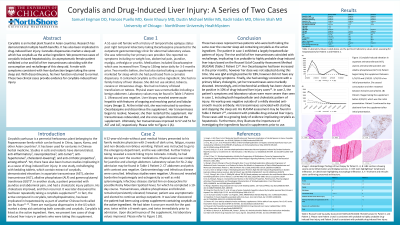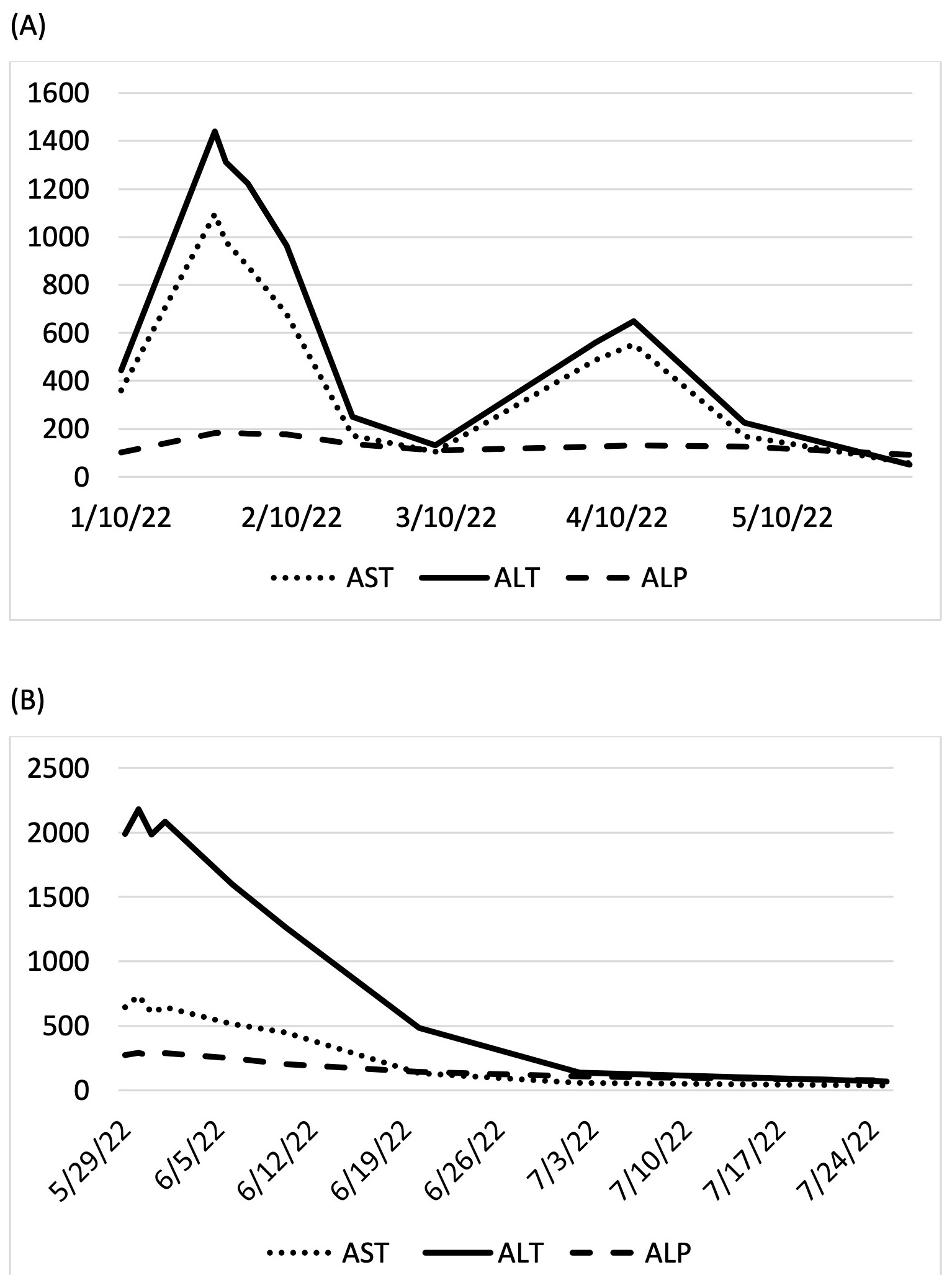Tuesday Poster Session
Category: Liver
P3938 - Corydalis and Drug-Induced Liver Injury: A Series of Two Cases
Tuesday, October 24, 2023
10:30 AM - 4:00 PM PT
Location: Exhibit Hall

Has Audio
- SE
Samuel Engman, DO
Northshore University Healthsystem
Evanston, Illinois
Presenting Author(s)
Samuel Engman, DO1, Frances Puello, MD2, Kevin Khoury, MD3, Dhiren Shah, MD1
1Northshore University Healthsystem, Evanston, IL; 2University of Chicago/Northshore, Evanston, IL; 3University of Chicago, Northshore University Healthsystem, Evanston, IL
Introduction: Corydalis is a plant found in many Asian countries. Research has demonstrated many health benefits. It has also been implicated as a cause of drug-induced liver injury. In fact the active compound in corydalis, tetrahydropalmatine, has been implicated in hepatotoxicity. Here, we present two patients with drug-induced liver injury who were taking a sleep supplement with corydalis as the active ingredient.
Case Description/Methods: Patient 1 is a 51-year-old female with a history of temporal lobe epilepsy status post right temporal lobectomy presented with abnormal laboratory values. She reported no symptoms. She had previously started taking a sleep supplement with corydalis as the active ingredient. She had no pertinent personal or familial history. Physical exam was unremarkable. Transaminases were elevated. Liver biopsy revealed severe acute hepatitis with features of ongoing and resolving portal and lobular injury. She discontinued the supplement. Her transaminases began to resolve; however, she then restarted the supplement. Her transaminases rebounded, and she once again discontinued the supplement with improvement in her transaminases.
Patient 2 is a 52-year-old male without past medical history presented with dark urine, fatigue, nausea and non-bloody non-bilious vomiting. Transaminases and cholestatic markers were elevated. Physical exam was notable for jaundice and a benign abdomen. Ultrasound revealed borderline hepatomegaly and echogenicity as well as mild splenomegaly. Transaminases and cholestatic markers remained elevated; however, symptoms resolved. It was later discovered the patient had been using a sleep supplement containing corydalis as the active ingredient. He had taken it once per month for the past year, twice within a 6-week span, and twice immediately prior to admission. Upon discontinuance of the supplement, his laboratory values improved.
Discussion: Patient 1 exhibited a largely hepatocellular pattern of injury. The rise and fall of her transaminases coincided with rechallenge, implicating it as the causative agent based on the Roussel Uclaf Causality Assessment Method. Patient 2's symptoms and laboratory values were more severe, including both hepatocellular and cholestatic pattern of injury. His transaminases coincided with starting and stopping the sleep aid. These cases add to a growing body of evidence implicating corydalis as hepatotoxic. Furthermore, they illustrate the importance of investigating the ingredients found in supplements prior to use.

Disclosures:
Samuel Engman, DO1, Frances Puello, MD2, Kevin Khoury, MD3, Dhiren Shah, MD1. P3938 - Corydalis and Drug-Induced Liver Injury: A Series of Two Cases, ACG 2023 Annual Scientific Meeting Abstracts. Vancouver, BC, Canada: American College of Gastroenterology.
1Northshore University Healthsystem, Evanston, IL; 2University of Chicago/Northshore, Evanston, IL; 3University of Chicago, Northshore University Healthsystem, Evanston, IL
Introduction: Corydalis is a plant found in many Asian countries. Research has demonstrated many health benefits. It has also been implicated as a cause of drug-induced liver injury. In fact the active compound in corydalis, tetrahydropalmatine, has been implicated in hepatotoxicity. Here, we present two patients with drug-induced liver injury who were taking a sleep supplement with corydalis as the active ingredient.
Case Description/Methods: Patient 1 is a 51-year-old female with a history of temporal lobe epilepsy status post right temporal lobectomy presented with abnormal laboratory values. She reported no symptoms. She had previously started taking a sleep supplement with corydalis as the active ingredient. She had no pertinent personal or familial history. Physical exam was unremarkable. Transaminases were elevated. Liver biopsy revealed severe acute hepatitis with features of ongoing and resolving portal and lobular injury. She discontinued the supplement. Her transaminases began to resolve; however, she then restarted the supplement. Her transaminases rebounded, and she once again discontinued the supplement with improvement in her transaminases.
Patient 2 is a 52-year-old male without past medical history presented with dark urine, fatigue, nausea and non-bloody non-bilious vomiting. Transaminases and cholestatic markers were elevated. Physical exam was notable for jaundice and a benign abdomen. Ultrasound revealed borderline hepatomegaly and echogenicity as well as mild splenomegaly. Transaminases and cholestatic markers remained elevated; however, symptoms resolved. It was later discovered the patient had been using a sleep supplement containing corydalis as the active ingredient. He had taken it once per month for the past year, twice within a 6-week span, and twice immediately prior to admission. Upon discontinuance of the supplement, his laboratory values improved.
Discussion: Patient 1 exhibited a largely hepatocellular pattern of injury. The rise and fall of her transaminases coincided with rechallenge, implicating it as the causative agent based on the Roussel Uclaf Causality Assessment Method. Patient 2's symptoms and laboratory values were more severe, including both hepatocellular and cholestatic pattern of injury. His transaminases coincided with starting and stopping the sleep aid. These cases add to a growing body of evidence implicating corydalis as hepatotoxic. Furthermore, they illustrate the importance of investigating the ingredients found in supplements prior to use.

Figure: Figure 1 Corydalis-induced elevation in aspartate aminotransferase (AST), alanine aminotransferase (ALT) and alkaline phosphatase (ALP): (A) Patient 1 began taking the supplement between 1/10/22 and 2/10/22. 2/10/22 is her initial presentation. She ceased consumption and then restarted between 3/10/22 and 4/10/22. (B) Patient 2 began taking the supplement before 5/29/22, which was the initial presentation. Patient 2 continued to stay abstinent from the supplement after initial presentation.
Disclosures:
Samuel Engman indicated no relevant financial relationships.
Frances Puello indicated no relevant financial relationships.
Kevin Khoury indicated no relevant financial relationships.
Dhiren Shah indicated no relevant financial relationships.
Samuel Engman, DO1, Frances Puello, MD2, Kevin Khoury, MD3, Dhiren Shah, MD1. P3938 - Corydalis and Drug-Induced Liver Injury: A Series of Two Cases, ACG 2023 Annual Scientific Meeting Abstracts. Vancouver, BC, Canada: American College of Gastroenterology.
